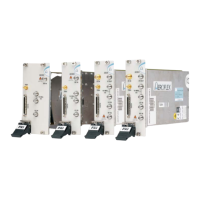GENERAL INFORMATION
10
Data capture and processing
Sample data can be output via LVDS in real time, useful for streaming applications. Data can
also be captured to internal memory and read out over the PCI bus.
For narrowband signal analysis, the module provides internal digital down-conversion and
decimation. Lowering the sample rate allows longer events to be captured. The module
contains digital resampling filters that allow you to set the sample rate, as well as numerous
preset values associated with common digital communications standards.
Signal routing
A configurable routing matrix provides flexibility in how you interconnect signals on the PXI
backplane, the LVDS and TTL front-panel inputs, and the module’s internal functions.
Predefined routing scenarios can be loaded, or new scenarios created to meet particular
requirements.
Triggering and synchronization
The module synchronizes to an external 10 MHz signal (generally supplied by a 3010 Series
RF synthesizer). Triggering is external, from the PXI backplane or directly from the front-
panel LVDS connector or SMB TTL input, or internal, from the internal timer or level trigger.
List mode
List mode enables very fast settling times for new instrument configurations. In list mode, up
to 128 internal hardware settings are pre-calculated and stored, providing fast switching of
frequency and level whilst maintaining RF output accuracy. List addresses are sourced
externally or from an internal counter driven by the test application controlling the
3030 Series module.
Software
A 3030 Series module is supplied with a VXI PNP driver and soft front panel for use as a
standalone module. It is also supplied with an instrument-level signal generator soft front
panel, a dll, a COM object, and a .net assembly for use with a 3010 Series RF synthesizer.

